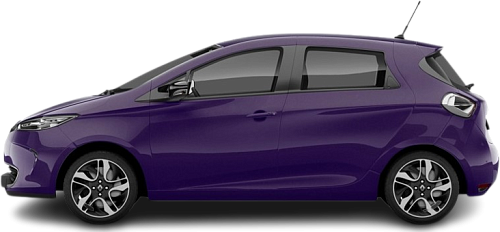Global EV Comparison: Nissan Leaf 24 kWh vs Renault Zoe Van Z.E. 40 R90
Struggling to Decide? Let AI Help!
Your AI Summary Is Ready!
General Info
Since both vehicles have been discontinued, they are now only available on the used car market. You can get the Nissan Leaf 24 kWh (2013-2018) for as low as €5950, while the Renault Zoe Van Z.E. 40 R90 (2016-2019) begins at €6950.
The two vehicles share the same body style: Hatchback.
| Property | Nissan Leaf 24 kWh | Renault Zoe Van Z.E. 40 R90 |
|---|---|---|
| Years of Production | 2013-2018 | 2016-2019 |
| Current Status | Discontinued | Discontinued |
| Country of Manufacture | Japan, UK, USA | France |
| Body Style | Hatchback | Hatchback |
| Market Availability | EU, USA | EU |
| Price Europe (Used) | €5950 | €6950 |
| GCC Score | 4.3 | 5.3 |
Range and Efficiency
The Renault Zoe Van Z.E. 40 R90 (2016-2019) boasts a greater real-world range, a larger battery, and superior energy efficiency compared to the Nissan Leaf 24 kWh (2013-2018).
| Property | Nissan Leaf 24 kWh | Renault Zoe Van Z.E. 40 R90 |
|---|---|---|
| Range (EPA) | 135 km | - Range (EPA) |
| Range (WLTP) | - Range (WLTP) | 317 km |
| Range (GCC) | 139 km | 286 km |
| Battery Capacity (Nominal) | 24 kWh | 44.1 kWh |
| Battery Capacity (Usable) | 22 kWh | 41 kWh |
| Efficiency per 100 km | 15.8 kWh/100 km | 14.3 kWh/100 km |
| Efficiency per kWh | 6.32 km/kWh | 6.98 km/kWh |
| Range and Efficiency Score | 5.2 | 6.6 |
Charging
Both vehicles utilize a standard 400-volt architecture.
The Renault Zoe Van Z.E. 40 R90 (2016-2019) has no DC fast charging capability, whereas the Nissan Leaf 24 kWh (2013-2018) can charge at up to 50 kW.
The Renault Zoe Van Z.E. 40 R90 (2016-2019) features a more powerful on-board charger, supporting a maximum AC charging power of 22 kW, whereas the Nissan Leaf 24 kWh (2013-2018) is limited to 3.3 kW.
| Property | Nissan Leaf 24 kWh | Renault Zoe Van Z.E. 40 R90 |
|---|---|---|
| Max Charging Power (AC) | 3.3 kW | 22 kW |
| Max Charging Power (DC) | 50 kW | - Max Charging Power (DC) |
| Architecture | 400 V | 400 V |
| Charge Port | CHAdeMO | Type 2 (Mennekes) |
| Charging Score | 2.7 | 6.1 |
Performance
Both vehicles are front-wheel drive.
The Nissan Leaf 24 kWh (2013-2018) boasts greater motor power and accelerates faster from 0 to 100 km/h.
| Property | Nissan Leaf 24 kWh | Renault Zoe Van Z.E. 40 R90 |
|---|---|---|
| Drive Type | FWD | FWD |
| Motor Type | PMSM | PMSM |
| Motor Power (kW) | 80 kW | 68 kW |
| Motor Power (hp) | 107 hp | 91 hp |
| Motor Torque | 254 Nm | 220 Nm |
| 0-100 km/h | 11.5 s | 13.2 s |
| Top Speed | 144 km/h | 135 km/h |
| Performance Score | 2.2 | 1.7 |
Dimensions
The Nissan Leaf 24 kWh (2013-2018) is longer and wider, but about the same height as the Renault Zoe Van Z.E. 40 R90 (2016-2019).
The Nissan Leaf 24 kWh (2013-2018) boasts a more extended wheelbase.
| Property | Nissan Leaf 24 kWh | Renault Zoe Van Z.E. 40 R90 |
|---|---|---|
| Length | 4445 mm | 4084 mm |
| Width (with Mirrors) | 1967 mm | 1945 mm |
| Width (w/o Mirrors) | 1770 mm | 1730 mm |
| Height | 1550 mm | 1562 mm |
| Wheelbase | 2700 mm | 2588 mm |
Cargo and Towing
Neither car is equipped with a frunk (front trunk).
Neither vehicle is officially rated for towing in in the EU.
| Property | Nissan Leaf 24 kWh | Renault Zoe Van Z.E. 40 R90 |
|---|---|---|
| Number of Seats | 5 | 2 |
| Curb Weight | 1474 kg | 1480 kg |
| Cargo Volume (Trunk) | 370 l | - Cargo Volume (Trunk) |
| Cargo Volume (Max) | 720 l | 1000 l |
| Cargo Volume (Frunk) | - Cargo Volume (Frunk) | - Cargo Volume (Frunk) |
| Towing Capacity | - Towing Capacity | - Towing Capacity |
| Cargo and Towing Score | 4.6 | 4.2 |




